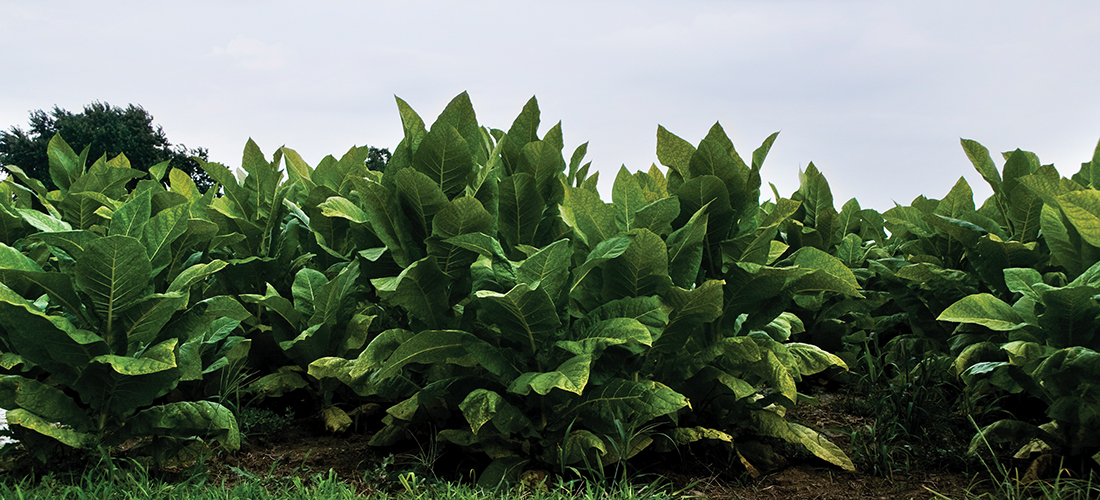
An ode to Nabs, gnats and gummy leaves that stir memories
By Tom Allen
The hardest work I’ve ever done. That’s how I described “barning tobacco” to a young relative who knew little of the history behind harvesting North Carolina’s infamous bright leaf. The heat and humidity extracted plenty of sweat. Mingle that with dirt and tobacco gum, throw in a hoard of gnats and a day’s labor sounds miserable. It was. And I loved it.
Early 19th century innovation introduced a tobacco variety that thrived in the coastal plain’s sandy soil. When leaves turned a yellow-green, the sugar content had reached its peak. The flavor of this quick-cured leaf became popular with smokers; soon North Carolina led the nation in tobacco production.
For decades, tobacco was picked by hand. Migrant workers harvested leaves for larger operations, but on small farms, for a boy willing to work, tobacco offered summer income and poignant memories.
For me, growing up in rural Carolina during the 1970s, barning tobacco meant rising early, sticky leaves dripping with dew, and long days of humid heat.
The farmer I worked for was kind and easygoing. “Mr. Gerald” would make the rounds in our community, picking up teenage boys eager to work. He knew us and we knew each other. We played together, attended school together, worshipped together. Harvesting tobacco, also known as priming, was an extension of community.
Our dress code was far from summer casual. Clothes protected us from the blistering sun and sticky sap. Everything was old or worn — tennis shoes, faded jeans, dad’s long-sleeved shirt, a dirty ball cap. After the final harvest, we pitched the rags.
Those first primings were the hardest. Harvesting sand lugs, bottom leaves that hugged the soil, nearly broke our backs. As summer burned into fall, we worked our way down the rows and up the stalks, snapping leaves with one hand, cradling them under the other arm. Each harvest brought less bending. As stalks became leafless, ventilation improved. In a tobacco field, you welcome any whiff of a breeze.
Mr. Gerald, out of kindness, gave younger boys rows closest to the tractor-pulled trailer. Kids hardly ever quit. A few steps and they could slap their harvest on the “drag,” a name recalling days when mules pulled harvesting sleds through the fields. Three rows harvested, then a break. Water-filled coolers were always on the drag. Mr. Gerald took us home for lunch and maybe a quick rest before the afternoon stint. He provided twice-daily snacks, mostly Honey Buns, Twinkies and Lance cheese Nabs. We poured down Dixie cups filled with crushed ice and Pepsi. Breaks were also for laughing, horseplay, and listening to our boss expound on politics or religion.
In the afternoon, with harvesting finished for the day, we stopped by the barn where women piled leaves on an electric contraption that strung primings onto wooden sticks. Mr. Gerald’s older sons hoisted those heavy sticks, straddled the barn’s tier poles and hung the leaves to cure. A rite of passage (and a real test of strength) came when an older boy was allowed to straddle the poles and “hang.” One day of straddling was enough for me.
On Friday, Mr. Gerald came to my home and handed me a small manila envelope marked with my name and the amount — $66.37 or $72.81 or $52.95. I have no idea why he didn’t round those numbers. I never calculated or knew my hourly wage. What mattered was hard work, mixed with a little fun, paid off.
North Carolina remains number one in tobacco production, although that production has declined substantially. The tobacco barns of my youth, if still standing at all, are dilapidated icons from another era. Automation and galvanized bulk barns replaced hand-harvesting and flue-curing. Tobacco warehouses have become condos and boutique malls; stained boards, reclaimed and refinished, are prized as flooring in pricey homes.
The ethics of growing tobacco have changed. Tobacco has always been a strange bedfellow in the Bible Belt. While the bright leaf fueled the state’s economy for decades, providing income to small family farms and resources that built colleges, hospitals, even churches, pulpit-pounding preachers (many of them paid from the tithes of tobacco farmers) railed against the evils of cigarettes. The evidence that smoking was deadly continued to mount. Some farmers still wrestle with growing a crop that, when processed, lit and inhaled, can cause debilitation or death. Those tensions endure.
Sometimes, on a humid late summer night, if the wind is blowing just right, I catch a whiff of curing leaves, from a farm near our house in Whispering Pines. Every day I drive past tobacco fields. Occasionally, I see workers snapping off flowering tips or mechanical harvesters stripping ripened leaves. Though I have no desire to experience the heat and gnats and gummy leaves, I’m grateful for the work ethic, the rhythm of labor and leisure, of rest and recreation, those fields instilled. And sometimes, when I see a field of ripened leaves, I want to stop, spread out under a shady oak tree, and wash down a pack of Nabs with Pepsi from a Dixie cup, all the while pondering how tobacco roads still lead me home. PS
Tom Allen is minister of education at First Baptist Church, Southern Pines.





